#baru wickeni
Explore tagged Tumblr posts
Text
Baru: The Cleaver-Headed Crocodile
Ok back on my croc stuff, today discussing Baru. Like most the other crocs I've been talking about, Baru was a mekosuchine, a member of an endemic radiation of crocodilian native to Australasia. Baru is easily among the largest of this group and among the most robust, with massive curved teeth and almost inflated looking jaws. Left my interpretation of Baru darrowi, right the illustration by Willis et al. from 1990.
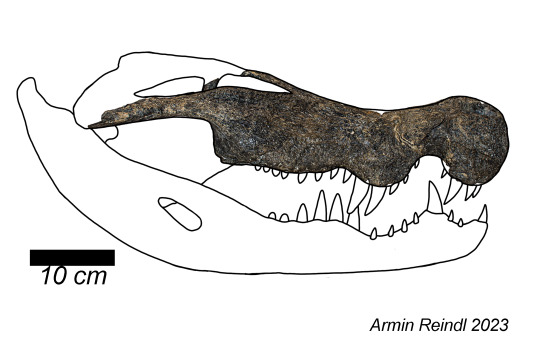

My reconstruction differs subtly in some regards, obviously the jaw material shown is from Ristevski et al. 2023 and elements of the posterior skull are based on the older Baru wickeni. My mandible also turned out slightly different, tho the quality of the images in the original description is not great so that is not guaranteed.
Anyhow, this head likely sat atop the body of what was a decently large crocodilian, with estimates suggesting four or even five meters in length for both currently recognized species Baru wickeni and Baru darrowi. As you can see below, I went for the lower estimate (which is the one given by proper publications), which still renders an immense animal all things considered, certainly holding up with many crocs of today.

Currently, there's two recognized species, one unnamed species and one that has been reassigned. The older of the named species is Baru wickeni, which was found in the Lake Eyre Basin and Riversleigh World Heritage Area during the late Oligocene. Like I already said, it was approximately as large and robust as the later Baru darrowi, but did differ in some regards. The skull had much more prominent crests, the nasal bone extended into the opening for the nares and importantly, the cutting edges of the teeth were smooth.
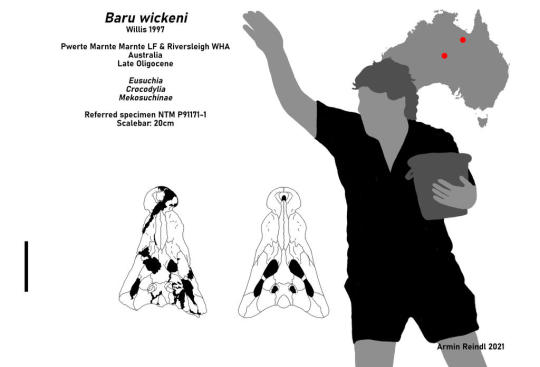
During the Miocene, Baru wickeni would be replaced by Baru darrowi, known from younger strata of the Riversleigh and the Bullock Creek fauna. Baru darrowi had less prominent crests, but in turn slight serrations on its teeth. Also the nasal bones did not extend into the nares. Baru darrowi is the species shown at the start.
The other two are then the unnamed Baru species from the Alcoota fossil site and "Baru" huberi. I talked about the latter before and how it is now thought to be something else entirely. Which leaves us with the Alcoota form. Generally regarded as a distinct species, fossils of the Alcoota Baru have been found from 2000 onwards near Alice Springs and appear to represent an animal more robust than the other known Baru. Below you can see a skeletal mount on exhibition at the Megafauna Central in Alice Springs (image by Aussie Bucket List) and a skull held by Adam Yates, an important researcher of this animal.
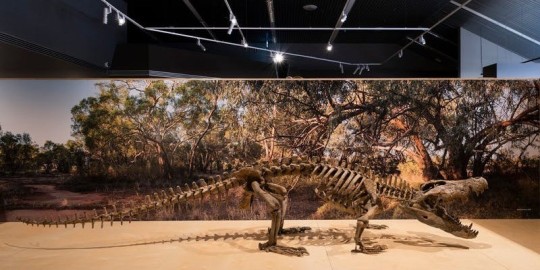
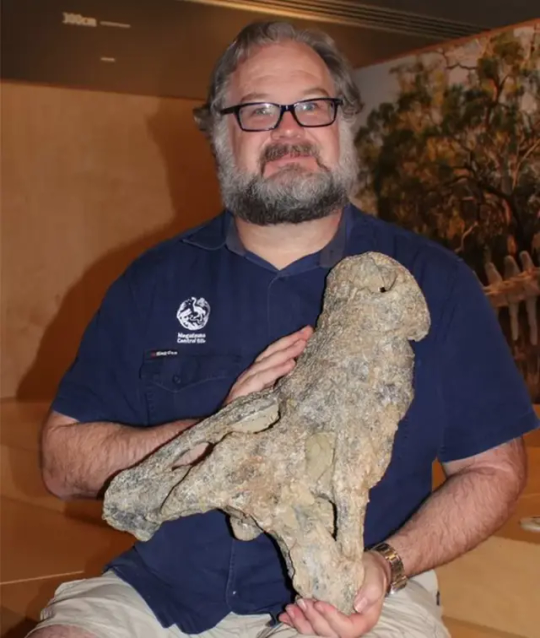
A little side note I want to mention is the name Baru. As you might have guessed from the etymology of various other mekosuchines (Kambara, Mekosuchus, Quinkana, Kalthifrons), the name actually ties into the native People of Australia. Specifically, Baru is a figure in the mythology of the East Arnhem Region, which describes him as a sort of totem crocodile that brought law to the lands he named. Baru also had a fight with Jarkitj (Willy Wagtail) after stealing fire for himself. Sadly I couldn't find much about the mythical Baru beyond a brief summary written up by George Pascoe Gaymarani you can read here.
Returning to the animal, one would suspect that the robust skull meant that it didn't quite hunt like modern crocodiles, especially considering the serrated teeth found in the younger species. Well, tho nothing concrete is known Willis and colleagues speculate that this might have been an adaptation to shallower waters. While modern crocs tend to ambush prey, grab it using a strong bite and conical teeth and then proceed to drown it, Baru may not have had that option. A modern croc can just drag a zebra for instance into deep water, weaken it and let go to adjust its grip without the risk of it getting away. In shallow waters, this may have been too risky and lead to prey escaping. So Baru's robust head and curved, sometimes serrated teeth were built to inflict a lot of damage upon prey when lunging, securing the bite and incapacitating it. Willis estimates that it may have taken prey as heavy as 300 kilos.
There's also the interesting tidbit of Baru wickeni coexisting with a diverse croc fauna, yet being conspicuously absent from more southern regions of Australia despite entering the respective drainage basin. I go into more detail while talking about Australosuchus, but the jist of it is that Baru was likely not as cold resistant as Australosuchus and thus not found as far north.
Alas, as with other mekosuchines, not much art of Baru exists aside from this absolutely fantastic piece by @knuppitalism-with-ue
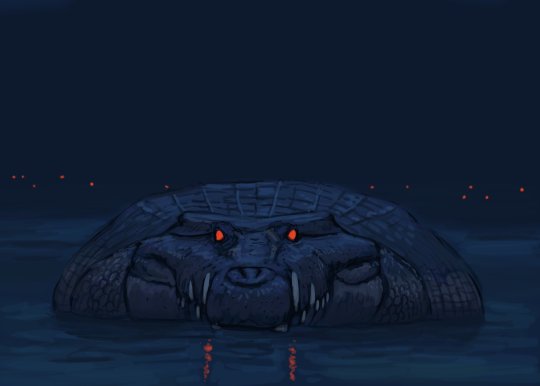
As per usual, this deep dive is brought to you as part of me redoing the wikipedia page of this genus, which resulted in a major size increase. The image below is just to show the difference, but if you want to read it here's the link: Baru - Wikipedia
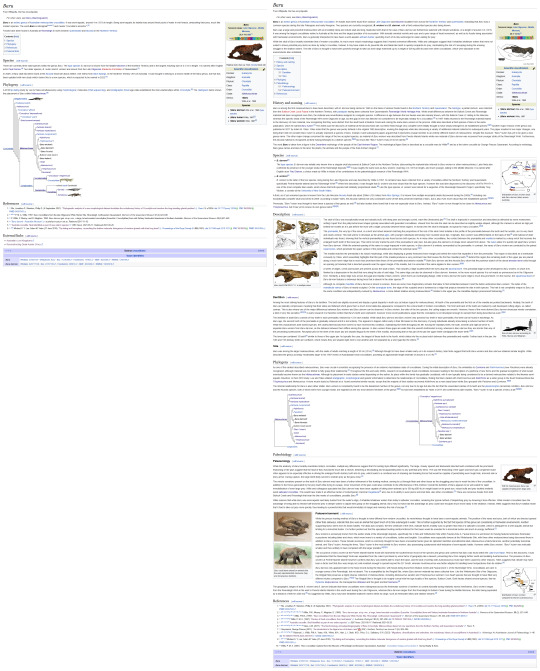
#mekosuchinae#wikipedia editing#wikipedia#baru#baru wickeni#baru darrowi#baru huberi#croc#crocodile#paleontology#palaeoblr#prehistory#oligocene#miocene#australia#long post
115 notes
·
View notes
Text
Baru is probably one of the more underappreciated crocodiles of Australia. Like most of the endemic crocs, its a mekosuchine, tho unlike the terrestrial Quinkana Baru fills a more traditional semi-aquatic rolle in its ecosystem. There's a lot of species (tho at least one is likely to be a distinct genus) that were the dominant ambush predators of the Oligocene and Miocene. I'll have to dig deeper eventually, so I expect to find even more interesting stuff. Also here's the skulls of Baru darrowi (from Willis, Murray & Megirian 1990) and Baru wickeni (by yours truly)


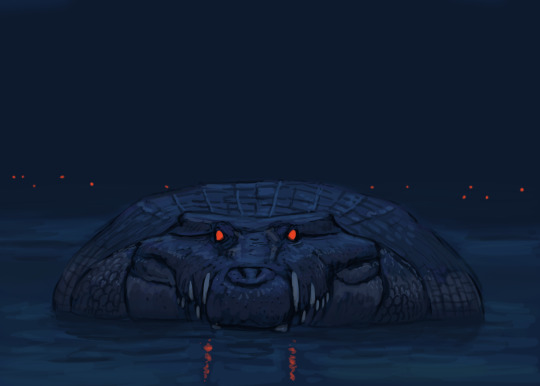
Another #paleostream sketch
Baru, a large, broad snooted, mekosuchians crocodile.
#baru#baru wickeni#baru darrowi#mekosuchinae#crocodylia#australia#miocene#oligocene#croc#palaeblr#paleontology
3K notes
·
View notes
Text
"Baru" huberi
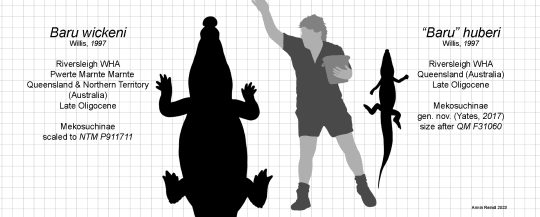
Baru is a genus of decently big mekosuchine crocodilian from the Oligocene and Miocene of Australia. The two currently accepted species, Baru wickeni and Baru darrowi, clock in between 4 to 5 meters, which puts them in a range not dissimilar to today's niles and salties. But when Baru wickeni was named in 1997, a third species was also coined. Baru huberi, simply described as having been "much smaller" Having started working on the wikipedia page for Baru recently, I did get curious to see how much smaller and well the results are....I mean "much smaller" seems like an understatement to me. Baru wickeni, which lived in the same area and at the same time as "Baru" huberi, dwarfed the other mekosuchine. Which brings us to "Baru" huberi's TRUE identity.
You see, tho named as a species of Baru, mekosuchine research has been mostly confied to the last 30 years and this paper came fairly early on in our understanding of the group, Naturally, things move around and change, as was the case for "Baru" huberi. Nowadays, researchers agree that "Baru" huberi is not a species of Baru. No, instead "Baru" huberi was a distinct genus seemingly more closely related to animals like Trilophosuchus or Mekosuchus and thus should get a new name. That...obviously didn't happen yet but we'll get there eventually. Just gotta give it some more time. Meanwhile, I tried my hands at reconstructing the animal behind the name.

The grey area marks the big unknowns in "Baru" huberi, all the stuff we don't know. I based my interpretation primarily on Trilophosuchus, the best known member of this branch. On the left, you see the sympatric Baru wickeni. It's an older illustration of mine, but one that should mostly hold up.
Baru huberi - Wikipedia
The biochronology and palaeobiogeography of Baru (Crocodylia: Mekosuchinae) based on new specimens from the Northern Territory and Queensland, Australia [PeerJ]
New crocodilians from the late Oligocene White Hunter Site, Riversleigh, northwestern Queensland (biostor.org)
#baru#baru wickeni#baru huberi#“baru” huberi#mekosuchinae#oligocene#australia#croc#crocodile#crocodilia#herpetology#herpblr#palaeoblr#paleontology#prehistory#skeletal#pseudosuchia
96 notes
·
View notes
Text
Baru iylwenpeny: The Last Baru
Happy to announce that there's just been a major new publication for mekosuchines. The Alcoota Baru, which I briefly touched upon in my post on the genus, has finally been named. The new name, Baru iylwenpeny (pronounced eel-OON-bin-yah), derives from the Eastern Anmatyerr dialect (part of the Arrernte language) and means "good at hunting". A name that seems quite fitting when you look at the skull.
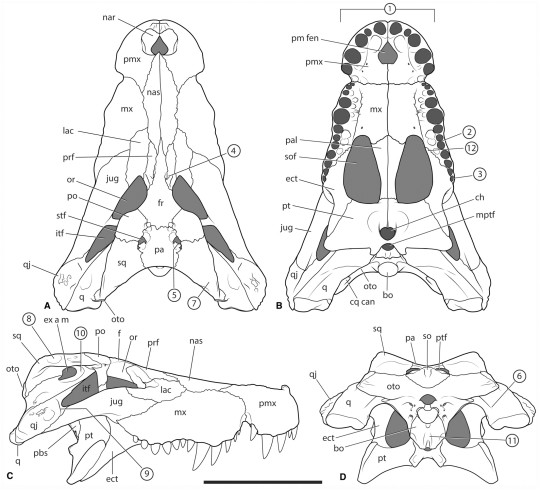
As a reminder, this animal stems from the Alcoota Fossil Site in Australia and dates to the Late Miocene, making it the youngest of the three recognized Baru species.
Previously this species was already referred to as being "the most robust Baru" and they weren't kidding. This thing looks more like something out of the Cretaceous than an animal that lived a mere 8 million years ago.
The morphology is interesting in many ways. Many of the ridges that are so prominent in Baru wickeni and less developed in Baru darrowi are absent. The seventh and eight tooth are so close they theres basically no space. Instead of four teeth like other Baru it has five in each premaxilla and the nasals reach the nares, like in Baru wickeni but unlike in Baru darrowi. The teeth also show the same small serrations as Baru darrowi and, unlike either of the other species, the jaws appear much less wavy not because they are but because the first festoon of the maxilla is followed up by a second one so developed it makes the first look almost flat. It's a fascinating mosaic of characters that makes its relation to the other species a puzzling question. You'd think that the ridges for instance point at it being derived? After all wouldn't it make sense? Baru wickeni had the most developed rigdes, Baru darrowi smaller ones and Baru iylwenpeny none. Plus, the teeth of Baru wickeni are smooth unlike those of later forms. Yet at the same time.... The fact that it has five teeth instead of four and the fact that the nasals reach the nares are both ancestral traits, so you'd expect it to be closer to the base.
Left: Baru wickeni Right: Baru darrowi
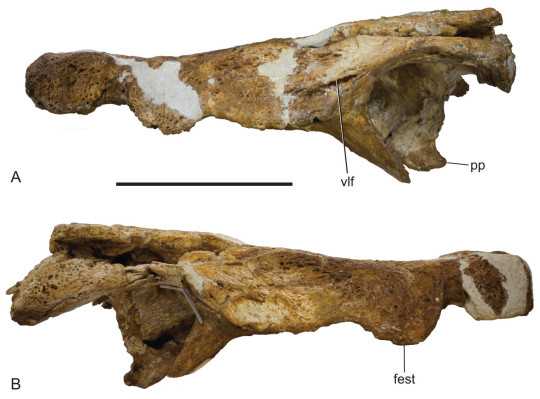
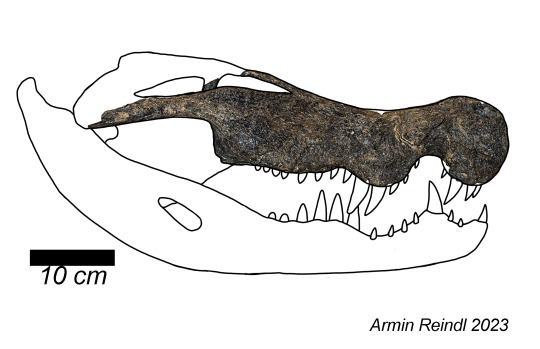
Well, while I think this isn't going to be the final place of this species among Baru, the most recent phylogenetic analysis suggests that Baru iylwenpeny was weirdly enough the basalmost species. Which means that it must have split from the other two species at the latest during the Late Oligocene and outlived the both of them without us ever knowing.
The paper also discusses how these animals may have gone extinct. If you look back at Kalthifrons, you might remember how I mentioned that mekosuchines kinda had a drop in diversity when transitioning from the Miocene to Pliocene. While the new paper avoids calling this a drop in diversity, it does highlight that there certainly was a turnover in fauna. The reason is an old enemy of mekosuchines. Climate. Yates and colleagues suggest that Australia was hit by an especially nasty dry period at the end of the Miocene, severe enough to drive Baru to its death but not severe enough to whipe out all mekosuchines. And after Baru was gone, Kalthifrons and Paludirex moved into the open niche.
There's also a final little piece of information that's not focused on yet really fascinating. Baru iylwenpeny had a friend. At least one other croc lived at the Alcoota site during the Late Miocene and tho it hasn't been studied in full yet, one thing is apparently known. It was a relative to the Bullock Creek taxon that coexisted with Baru darrowi and a relative to "Baru" huberi, the small croc that coexisted with Baru wickeni. This grouping has yet to be given a name, but its fascinating to me that each Baru species seemingly coexisted with a much smaller mekosuchine. Alas, like Baru this lineage seems to have fallen victim to climate change.
Baru wickeni and "Baru" huberi, in truth an unnamed genus.
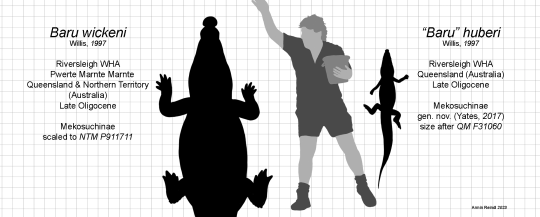
The paper is accessible here for those that wan't to dive deeper into the matter. I'll also be working on an updated size chart, this time featuring all three species of Baru, tho I can already tell you that despite being more robust its surprisingly not that much larger.
The last Baru (Crocodylia, Mekosuchinae): a new species of ‘cleaver‐headed crocodile’ from central Australia and the turnover of crocodylians during the Late Miocene in Australia (wiley.com)
#baru#baru iylwenpeny#alcoota baru#alcoota fossil site#miocene#paleontology#palaeoblr#crocs#crocodile#mekosuchinae#paleontology news#prehistory
101 notes
·
View notes
Text
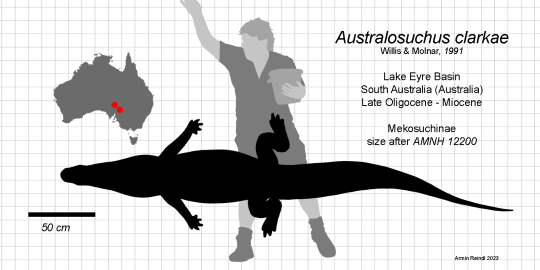
A comparably brief one this time, but this is Australosuchus. Australosuchus is yet another mekosuchine from the Oligocene to Miocene, roughly contemporary with "Baru" huberi from last time. At around 3 meters long, its a medium-sized animal with a more or less generalist semi-aquatic bauplan known from plentiful remains all found in South Australia. And I do mean plentiful. We not only have many parts of the body, but plenty of specimens too.
Regarding its anatomy there's just one thing I wanna highlight which is the occlusal pit for the fourth dentary tooth. If you look at crocodile skulls, you'll often notice how the snout sorta constricts fairly early on. This is because the fourth tooth of the lower jaw neatly slides into this region. However, in Australosuchus this is less a notch or constriction, but a full on hole in the skull thats almost entirely enclosed. I just think thats neat.


Little is written about its biology, safe for one really fascinating thing. It's range. When looking at the fossil locality where the remains of this croc were found, you'll notice that it appears to be the only crocodilian around. By contrast, if you were to go to any locality in the north, like the famous Riversleigh WHA, you'll find a multitude of mekosuchine species of all shapes and sizes....yet no Australosuchus. For some time, it was suggested that there was simply a geographic barrier, a dessert perhaps. That the species in the north just couldn't reach the Lake Eyre Basin. But finds from Pwerte Marnte Marnte have shown that the northern forms, like Baru wickeni, were in fact present in the basin. So why not further south? Well, Adam Yates suggests that latitude was the deciding factor. Yates argues that the species from the north like Baru were unable to handle the climate of southern Australia, which is why although present in the basin, Baru is not found anywhere below the 27° South. However, Australosuchus, which may have been more cold resistant (like modern alligators) was capable of surviving the lower temperatures, thus being the only crocodilian found in these southern waters during the Late Oligocene and Miocene. The whole thing is illustrated by Yates too for those who want a visual aid.
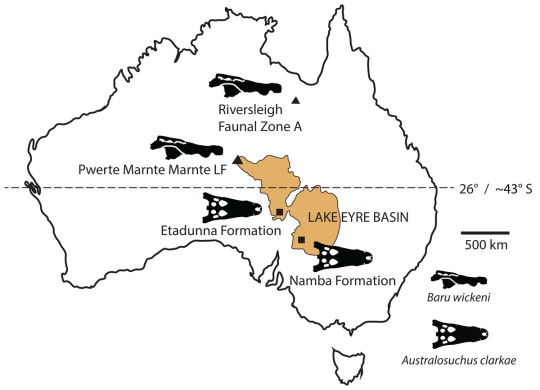
#mekosuchinae#australosuchus#baru#croc#crocodile#crocodilia#palaeoblr#paleontology#prehistory#herpetology#australia#oligocene#miocene
36 notes
·
View notes